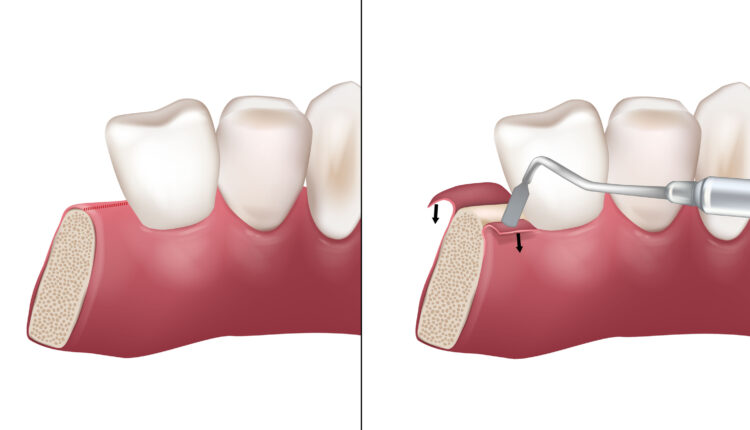
GBR and Growth Factors Deliver 10 mm Bone Gain Without Autograft
A recent case report in Perio Update showcases a staged guided bone regeneration (GBR) approach using a composite graft and rh-PDGF to overcome a severe ridge defect, achieving an impressive 10 mm horizontal bone gain without harvesting autogenous bone. This technique demonstrates the power of combining advanced biomaterials and biologics to enhance both the esthetic and functional outcomes of complex ridge augmentation procedures.
The case report that appeared in the last edition of Perio Update highlights the strategic use of guided bone regeneration (GBR) and growth factors to overcome a severe combined ridge defect and achieve long-term stability and esthetic success. This case report demonstrates the successful application of a staged surgical approach to achieve combined vertical and horizontal site augmentation. With the advancement of biomaterials, GBR has become the most frequently preformed procedure for most of the horizontal and vertical ridge augmentation procedures. A staged approach was chosen in this case because the initial width of the ridge was not conducive to implant placement. A systematic review reported the average gain in the width following staged horizontal ridge augmentation was 3.9 mm.1 A greater gain in width close to 6 mm was reported by Urban et al.2,3
In this case, the final gain in width was close to 10 mm. We attribute this large gain to the following:
- Composite graft material used consisted of a 50/50 mixture of allograft and xenograft.
- Xenograft material has a high osteointegration capacity promoting host cells and vessel migration.
The inorganic bovine bone mineral has the potential to be colonized by CD44-positive osteocytes to promote neovascularisation. Their osteoconductive properties, combined with their very slow resorbing rate, maintain the volume of the regenerated bone over time.
The allograft contained 50/50 corticocancellous bone chips, providing an osteoconductive scaffold. The lack of osteogenic properties of these materials is overcome by the use of recombinant human platelet-derived growth factor (rh-PDGF). This growth factor is naturally produced during the early stages of healing accelerating the regenerative phase with early production of bloods vessels, anastomosis, osteoblasts, and fibroblast migration.4 The use of the rh-PDGF was aimed at promoting angiogenic growth inside the composite graft material and recruiting osteoblasts contributing new bone regeneration. The composite graft was stabilized by the use of a resorbable collagen membrane. The fixation of the membrane on the buccal and palatal aspect with titanium screws immobilized the graft material, allowing the formation of the desired amount of bone. Another factor that contributes to the success of this surgery was the application of the PASS principle (primary wound closure, angiogenesis, clot stability and space maintenance).5
This case report demonstrates that severe ridge deficiency can be reconstructed through advanced GBR surgery without the need for harvesting autogenous bone, therefore reducing the trauma to the patient by avoiding a second surgery site.
Remarkable bone regeneration can be achieved by using rhPDGF in conjunction with a composite graft material immobilized by a resorbable collagen membrane, as seen in the case study. It has further provided evidence regarding the potential use of the rh-PDGF in challenging situations with both vertical and horizontal bone defects. However, limited clinical evidence is available regarding this technique and the long-term success of the regenerated bone, including implant success.
References
- Sanz-Sanchez I, Ortiz-Vigon A, Sanz-Martin I, Figuero E, Sanz M. Effectiveness of lateral bone augmentation on the alveolar crest dimension: a systematic review and meta-analysis. J Dent Res. 2015;94:128S-142S.
- Urban IA, Nagursky H, Lozada JL. Horizontal ridge augmentation with a resorbable membrane and particulated autogenous bone with or without anorganic bovine bone-derived mineral: a prospective case series in 22 patients. Int J Oral Maxillofac Implants. 2011;26:404-414.
- Urban IA, Lozada JL, Jovanovic SA, Nagy K. Horizontal guided bone regeneration in the posterior maxilla using recombinant human platelet-derived growth factor: a case report. Int J Periodontics Restorative Dent. 2013;33:421-425.
- Chiantella GC. Horizontal guided bone regeneration in the esthetic area with rhpdgf-bb and anorganic bovine bone graft: a case report. Int J PeriodonticsRestorative Dent. 2016;36:e9-15.
- Wang HL, Boyapati L. “PASS” principles for predictable bone regeneration. Implant Dent. 2006;15:8-17.
This originally appeared in Boeriu S, Hottel TL, Chirla C, Chirla P. Achieving predictable bone regeneration without autogenous grafts. Decisions in Dentistry. 2025;11(2):36-39.

